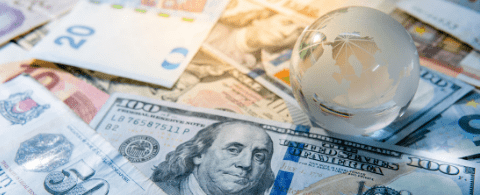U.S. Faster Payments – What We Can Learn from the Rest of the World
Posted by Christian Hibbard on 09 Mar 2021


Real-time payments are finally picking up speed in the United States. The RTP® network from The Clearing House (TCH) has seen consistent growth in its three-plus years of operation, and the Federal Reserve’s FedNowSM Service has recently confirmed its 2023 go-live plan. Domestic payment rails have come a long way in a few years, but we still have work to do before we match the success seen by some of our peers. The benefit of being at this stage is that we can study those successes, and use them to inform our efforts. There are currently fifty-six real-time payment schemes operating internationally. In this blog, we’ll hone in on three of the most interesting cases.
Japan
Originally an RTGS (real-time gross settlement) system, the Japan Bankers Association (JBA) Zengin system has been processing payments since 1973, with continual updates since then. Until 2018, it was able to process instant payments between two participating bank accounts during weekday business hours. In 2018 it was upgraded to be accessible 24x7. Despite the sophistication of the payment rails available, around 84% of people still use cash for day-to-day purchases. These obstacles to potential adoption are similar to those in the United States—even though the infrastructure necessary for economy-wide instant payments has been available for so long, the complexity and cost of entry are still a deterrent. The age of the system is also a concern for some, who question whether upgrading 70s-era banking infrastructure can be as efficient as building a new system altogether.
The move to 24x7 as well as using ISO 20022 standards are both intended to incentivize digital payments through the Zengin System. In addition, the Bank of Japan created a “FinTech Center” to incentivize innovation by private companies. This “cashless vision” was inspired largely by the massive expected influx of international attention during the now-delayed 2020 Olympics. An industry panel advocating for the switch to digital payments estimated that the country might have missed out on ¥1.2 trillion worth of transactions, had the year gone according to plan.
The Japanese government has begun offering rebates on digital purchases in combination with a sales tax hike. Some have criticized the measure, pointing out this might disproportionately affect the elderly and impoverished. This is certainly possible and mirrors similar concerns regarding checks in the United States. For as long as some hold onto the status quo, there will be some value in optimizing more aged solutions.
India
The paradigm example of a successful national instant payment system, India’s United Payments Interface (UPI), is about to enter its fifth year of operation. UPI is operated by a non-profit organization, the National Payments Corporation of India (NPCI). NPCI was formed after the Payment and Settlement Systems Act of 2007 by the Reserve Bank of India and the Indian Banks’ Association. Beginning with a pilot program of 21 banks, UPI has grown to 207 members as of January, and in that month, processed 968.7 million transactions.
India has over 1 billion mobile phone users, with rapidly growing smartphone ownership. In response, NPCI designed its network to be mobile-first. In combination with its open API accessibility, UPI has been able to reach a staggering number of users via upgraded or purpose-built mobile finance apps. PhonePe, the most popular payment app built on UPI, boasted over 250 million users in November 2020.
UPI connects multiple bank accounts into a single user interface, accessible from any participating mobile platform. Users are given a customizable “UPI ID” formatted similarly to an email address, as well as a pin code that is used to confirm transactions. This marks a huge improvement in simplicity for the end-user and is likely a huge factor in UPI’s continued success. The sender does not need to remember any long numeric code, and the receiver can decide into which account they would like their funds to be deposited.
Brazil
PIX is developed and operated by the Banco Central do Brasil (BCB) and is state-owned. By the end of its first operating week (Nov. 16 - 20, 2020), the service had already processed some 12 million transactions, worth around BRL 9 billion, or USD 1.7 billion. Users are structured into direct and indirect participants, similar to the RTP® network in the United States. Direct participants have an “instant payments account” with the BCB and can access the network directly. Indirect participants, with fewer members or less capital, have to partner with a direct participant as a liquidator.
One of the often-mentioned goals of PIX was to foster competition in the Brazilian banking industry. By offering a relatively accessible payment rail, neobanks and fintechs can reach the underbanked. This builds a financial foundation for the citizens, as well as shaking up the competitive strategy of the top banks. WhatsApp connected shortly after PIX’s debut and new “chat banks” like Zro are taking advantage of the disruption to capture a rapidly growing user base.
Like the other systems covered here, connection to PIX was mandated by the BCB for financial institutions with over 500,000 members. This no doubt contributed to the rapid growth in value sent and total transfer numbers. Already, the numbers reached in the initial weeks are now matched by the daily averages—between 5 and 6 billion Reais are sent in an average 24-hour window.
What It Means for the U.S.
There is no perfect analogue for the financial system of the United States. Innovation relies largely on demand from firms and end-consumers, yet the average person’s payments literacy is quite low. The actions taken by other governments and central banks to promote real-time payments is a non-starter in the US given the current political climate in Washington and the relative size and influence of the financial sector on our economy, so while slight changes and modifications are possible, overhauling the entire system is not expected. As a result, the best strategic moves to make real-time payments accessible and popular are often the hardest to make. For example, India and Brazil’s central banks mandated connection for the largest institutions. For better or worse, the Federal Reserve does not have this power and has to entice participation by other means.
As for actionable strategies that are employable here, there are still a few good lessons. The obvious one is offering a public network via the central bank. As we know, FedNow will be fulfilling this in 2023. This is crucial because it provides greater accessibility and reach, particularly to community financial institutions and credit unions. A real-time payments network only works if both sender and recipient are participants, so ubiquity needs to be the main goal.
Something that both TCH and the Fed could benefit from is broader outreach. India’s NPCI has gone to great lengths to educate not just financial institutions but also consumers on how to connect. In addition, they made the benefits of the system very clear from the beginning and were able to secure the support of both banks and service providers in advertising the UPI platform. The US Faster Payments Council, of which Alacriti is a participating member, has as part of its mission to educate the market on the value that payments modernization will bring to our economy. There is obviously more work to be done but this is a promising step.
Another lesson comes from Japan’s attempts to go digital. Japanese banks were expecting a massive influx of international tourism from the 2020 Olympics and used this to justify pushing instant digital payments. Of course, 2020 didn’t go according to plan, and as such, their justification was compromised. The takeaway is not to rely too heavily on one use-case or source of traffic. One potential boost could come from offering a rebate, like Japan’s government did, but perhaps without adding a sales tax as well. One of the benefits of real-time payments is the boost to efficiency—returning some of that capital freed up as a reward to early adopters is a shrewd move and makes it a much easier sell.
Overall, real-time payments are impacting all payment systems globally. Although countries are taking different approaches to implement faster payments, no economy has a blank slate—there is always a transition from existing practices. It is essential that American financial institutions support the existing infrastructure and needs of the market while setting the foundation for the future payments that will inevitably dominate. The players that stand out in the years to come will be the ones that collaborate and innovate on bridging that gap today.
For more on real-time payments, please see our blog, Why RTP, Why Now?
Alacriti’s Cosmos for RTP® enables financial institutions and organizations to quickly and seamlessly connect to The Clearing House’s RTP® network without the burden of significant infrastructure overhauls or capital investments. To speak with an Alacriti real-time payments expert, please contact us at (908) 791-2916 or info@alacriti.com.
Schedule A Personalized Demo
Schedule a Free Consultation





